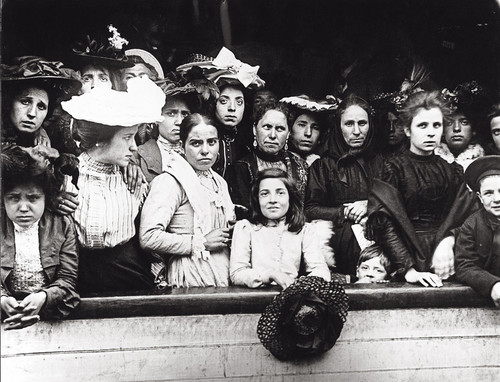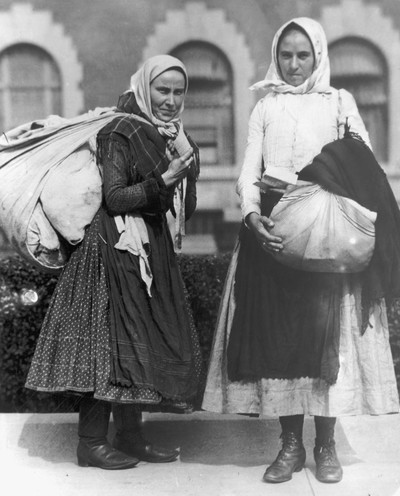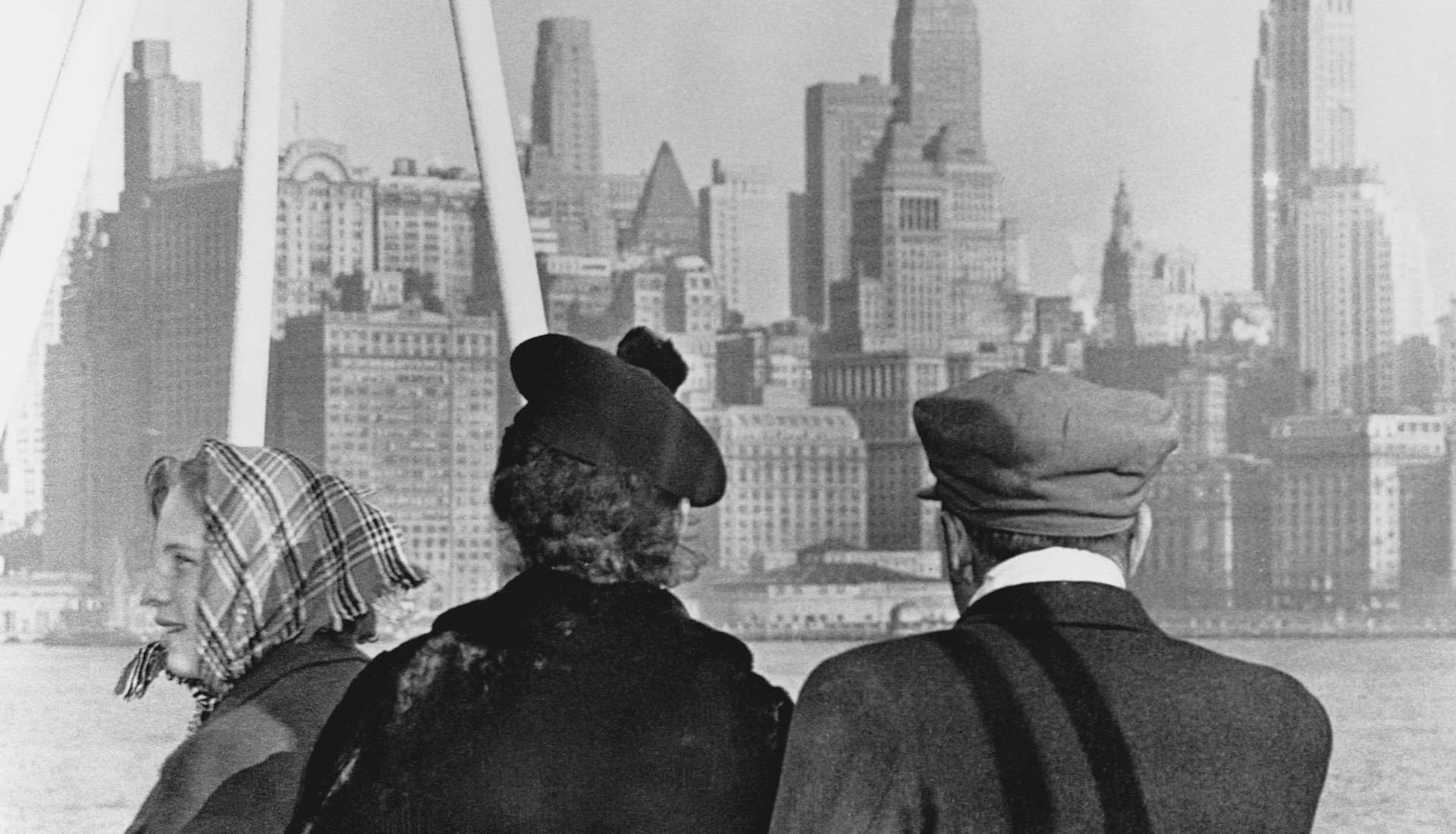Since 1790, the U.S. has taken a census that divides citizens into racial categories. These categories have transformed dramatically over the past 220 years along with U.S. demography. In 1790, there were three categories: “free whites”, “other free people”, and “slaves.” Over the next few centuries, new groups were added ranging from broad racial categories (“Asian”) to subsets (“Korean”, for example, was added as its own race in 1920, removed in 1950, re-added in 1970, and subsumed into “Asian” in 2000.)

Boat with displaced persons from World War II arriving at Ellis Island. Photo by Getty

Young woman and girl arriving at Ellis Island aboard the S.S. Baltic,1907. Photo by Getty
The most recent census, taken in 2010, divided Americans as follows: White, Black or African American, American Indian or Alaska Native, Asian, Native Hawaiian or Other Pacific Islander, or Some Other Race. In 1980, as a result of a huge increase in the Hispanic population, ‘Hispanic’ (or Latino, often the preferred term) was added as its own category, with a note that it is an ethnicity, not a race.
The lines between race and ethnicity were always blurred in the U.S., and the political manipulation of racial groups – most visible during election seasons – has inspired debate over whom, exactly, these racial groups include. In 1997, the American Anthropological Association warned of the dangers of dividing Americans by race:
“During the past 50 years, ‘race’ has been scientifically proven to not be a real, natural phenomenon,” they wrote. “More specific, social categories such as ‘ethnicity’ or ‘ethnic group’ are more salient for scientific purposes and have fewer of the negative, racist connotations for which the concept of race was developed.”
The AAA’s recommendations were not implemented and today Americans are taught to think of themselves as belonging to racial categories like white, black, or Asian. Within every category, however, are multiple ethnicities with distinct cultural differences as well as huge variations in when and how they arrived in America. Blacks who emigrated voluntarily from Africa or the Caribbean, for example, have a different relationship to the U.S. than descendants of African slaves brought to the U.S. by force (though both groups are subject to anti-black racism even today.)
Whiteness, in America, has always been a sliding scale
The same internal diversity exists for white Americans – most of whom were not seen as “white” upon arrival, but became accepted as white, gradually, over decades. Whiteness, in America, has always been a sliding scale. Anglo-Saxon Protestants who arrived in earlier centuries, for example, had more social advantages than more recent European arrivals. In general it seems that the further from Western Europe one’s ancestors are, the more subject one is to discrimination, which is why many groups deemed white by the U.S. census today – like Arabs – are not accepted as “white” by much of U.S. society.
Whiteness is a social construct, and one with concrete benefits. Being white in the U.S. has long meant better jobs and opportunities, and an escape from persecution based on appearance and culture. Although these structural advantages remain, the meaning of whiteness is still hotly debated – particularly during this election season.
Trump and his campaign have done their best to subsume all white Christian people into a collective group that opposes ethnic and religious minorities
But the fact that European Americans of multiple ethnicities identify as “white” does not mean that the importance of their ancestral homelands fades away. This is the lesson Americans are learning from Donald Trump, the first openly white supremacist candidate on a major party ticket. Trump has retweeted white supremacist groups and has the backing of the Ku Klux Klan. Other prominent Trump supporters include the “alt-right” (a younger, slicker branch of white supremacists) and “White Power” advocates.
Trump and his campaign have done their best to subsume all white Christian people into a collective group that opposes ethnic and religious minorities, like Muslims and Mexicans, who are presented as a threat to “real Americans”. As a result, white Trump fans have attacked members of these groups in the belief that they are defending Trump’s, and America’s, honor.
This is a doomed campaign strategy in a demographically diverse country like the U.S. But it is not only non-white Americans who are rejecting Trump. White Americans are also rejecting him – some simply because he is a horrendously unqualified and bigoted candidate, others for a new reason: their specific white ethnicities.
The discrimination endured by Polish immigrants
Recently, Americans of Eastern European descent have turned away from Trump due to Trump’s close ties with Russia. Many of these voters were once loyal Republicans who supported President Reagan for his strong support of the Eastern European countries which they or their ancestors fled, often because of Russian oppression.

Immigrants on board a ship arriving in New York, 1910. Photo by Getty
White ethnic heritage, played down by the census as well as by Trump’s approach to whiteness, still matters in the U.S.
Here it is important to understand how, exactly, Americans ‘become white’. The history of Polish-Americans is an illuminating example. Upon arriving in the U.S. en masse in the late 19th and early 20th century, Poles endured discrimination based on their appearance, religion and culture. cIn 1903, the New England Magazine decried the Poles’ “expressionless Slavic faces” and “stunted figures” as well as their inherent “ignorance” and “propensity to violence”. Working for terrible wages, Polish workers were renamed things like “Thomas Jefferson” by their bigoted Anglo-Saxon bosses who refused to utter Polish names.
The Poles, in other words, were not considered white. Far from it: they were considered a mysterious menace that should be expelled. When Polish-American Leon Czolgosz killed President William McKinley in 1901, all Poles were deemed potential violent anarchists. “All people are mourning, and it is caused by a maniac who is of our nationality,” a Polish-American newspaper wrote, pressured to apologize for their own people. The collective blame of Poles for terrorism bears great similarity to how Muslims (both in the U.S. and Europe) are collectively blamed today.
...and how the Polish later became “white”
But then something changed. In 1919, Irish gangs in blackface attacked Polish neighborhoods in Chicago in an attempt to convince Poles, and other Eastern European groups, that they, too, were “white” and should join them in the fight against blacks. As historian David R. Roediger recalls, “Poles argued that the riot was a conflict between blacks and whites, with Poles abstaining because they belonged to neither group.” But the Irish gangs considered whiteness, as is often the case in America, as anti-blackness. And as in the early 20th century Chicago experienced an influx not only of white immigrants from Europe, but blacks from the South, white groups who felt threatened by black arrivals decided that it would be politically advantageous if the Poles were considered white as well.
With that new white identity came the ability to practice the discrimination they had once endured
Over time, the strategy of positioning Poles as “white” against a dark-skinned “other” was successful. Poles came to consider themselves white, and more importantly, they came to be considered white by their fellow Americans, as did Italians, Greeks, Jews, Russians, and others from Southern and Eastern Europe, all of whom held an ambivalent racial status in U.S. society. Also, intermarriage between white ethnic groups led some to embrace a broader white identity.

Two young Polish peasant women ready to leave Ellis Island, c. 1910. Photo by Getty
With that new white identity came the ability to practice the discrimination they had once endured. Polish-Americans joined the “white flight” out of increasingly black cities like Chicago and Detroit in the 1960s and 1970s.
By the mid-20th century, the Poles had become “white”, but they were not quite white enough. They were referred to then as “ethnic whites” and put in a vulnerable position – not subject to hostile discrimination like blacks, but not able to receive the same advantages as whites of Western European ancestry either.
This tension was outlined in a 1970 speech by a young Polish-American politician named Barbara Mikulski, who went on to become a U.S. Senator for Maryland:
“America is not a melting pot. It is a sizzling cauldron for the ethnic American who feels that he has been politically courted and legally extorted by both government and private enterprise… The ethnic American also feels unappreciated for the contribution he makes to society. He resents the way the working class is looked down upon.”
How Trump exploits white ethnicity
Mikulski’s speech, and the 1970s-era concept of “ethnic whites”, are today considered relics of the past, as the broad census category of “white” is emphasized instead. But white ethnicity is important to reexamine today, as it is what Trump wants to exploit, without ever explicitly saying so.

Immigrants at Ellis Island waiting around and passing the time, c. 1900. Photo by Getty
Trump does not offer a coherent view of white identity, but instead heavily emphasizes threats to America from non-white people. Ethnic groups like Mexicans are characterized as “rapists”; religious groups like Muslims are designated “terrorists”, and white supremacist groups have embraced these characterizations. Trump’s emphasis on “the other” allows white people who do not fit into these categories to bond over a perceived common enemy.
Like Mikulski did in her speech, Trump talks about the difficult position of the working class – “forgotten workers” – whom he designates as white. In contrast, Mikulski was addressing “ethnic whites” whose economic conditions were worse in part due to discrimination they still faced from more established U.S. whites. These workers were not discriminated against for being white – an absurd argument which Trump fans make about themselves today – but for not being white enough. The workers Trump refers to are struggling not because of their race, but because of economic crises.
For Trump, whiteness is a weapon
Trump, clearly, has a different conception of race and disenfranchisement than Mikulski does. But where Mikulski simply identified the problem and looked for a solution, Trump uses the concept of whiteness to cause problems. The biggest difference lies in the solution Mikulski suggested:

Immigrants seated in the dining hall at Ellis Island, while waiters stand nearby. Photo by Getty
“Unfortunately, because of old prejudices and new fears, anger is generated against other minority groups rather than those who have power. What is needed is an alliance of white and black, white collar, blue collar and no collar based on mutual need, interdependence and respect, an alliance to develop the strategy for new kinds of community organization and political participation,” she concluded.
Acknowledging the ambiguous social status of “white ethnics”, Mikulski pushed for them to align with blacks and other disadvantaged groups to improve civic life for everyone. The goal was not to pursue “whiteness” as a social advantage, but to respect one’s own ethnic background and work with fellow Americans of all backgrounds and races to benefit society together. Trump and his supporters, on the other hand, want the opposite: for all white people – or the ones that they wish to include anyway – to align only with each other against non-white Americans. For Trump, whiteness is a weapon, much in the way it was used as a weapon against non-white groups earlier in the 20th century.
Former immigrants turned white supremacists
The Polish experience was not unique. While Poles were discriminated against for specific reasons – Catholicism, an initially low level of education, associations with Czolgosz’s anarchism – they shared many of the same negative experiences as other immigrant groups who arrived in the late 19th and 20th century. Italians were slandered with Mafia associations; Jews were (and still remain) targets of anti-Semitism and were frequently banned from social and political organizations. Irish who had arrived in earlier decades encountered hostility due to their religion and culture, especially from British Americans who retained old prejudices from home.Eventually, however, all these groups were deemed “white” – and today, they are considered white enough to be part of Trump’s white supremacist base.
Over the past year, Trump’s bigoted vision has resonated with many white Americans. Many supporters are the descendants of white ethnic immigrants who had faced discrimination just like the kind Trump and his fans display toward Mexicans, Muslims, and other recent arrivals to the U.S. Trump’s wife, Melania, is a Slovenian immigrant. Trump’s former campaign manager, Corey Lewandowski, is Polish-American. The ascent of a Polish-American to the head of a white supremacist campaign was perverse affirmation that, in the U.S., the Poles had indeed achieved “whiteness”.
A referendum on racism
As the history of the Poles in America shows, whiteness has always been a malleable category, used for political exploitation. But as the ties between Trump and Russia are revealed, and Trump’s white supremacist vision becomes more blatant – he recently hired a white supremacist journalist, Steve Bannon, as his campaign manager – even whites are rejecting him. His concept of whiteness honors neither heritage nor history, but is based on the exclusion and persecution of others. Trump’s idea of American society is reminiscent of the crude divisions of the 1790 census, which divided the population into broad categories of ruling whites and non-whites who lacked rights and power. As the reaction of Eastern European American former Trump supporters reveal, it is a vision that can easily backfire. Ethnic heritage, after all, continues to matter deeply.

Immigrant children being examined by city health officer upon arrival at the battery from Ellis Island during Typhus Scare. New York, 1911. Photo by Getty
The lessons of the Trump campaign are relevant for Europe as well. Right now, Poles in the UK are facing what some Polish Brits have called “racism” (others, uncertain whether Poles are now a race, call it bigotry) due to post-Brexit hostilities against Polish laborers. At the same time, some Poles in Poland have embraced white nationalism and the persecution of Muslim arrivals. The idea of Polish “whiteness” is ambiguous in Europe, much as it was in the United States. And all over Europe, white nationalist movements like Trump’s are on the rise, and making their way into mainstream politics. The best defense against this threat is universal compassion for the persecuted, and vigilance against those who attempt to stoke racist violence under the cloak of patriotism. The campaigns of Trump and other white supremacists are a referendum on racism, and it is up to citizens to determine whether they will succeed.
More from The Correspondent:
 What I had to tell my daughter about the America of her black classmates
For centuries, black Americans have been systematically brutalized. Now that we have video evidence – going viral – you would expect things to change. But even video cannot open the eyes of those who refuse to see.
What I had to tell my daughter about the America of her black classmates
For centuries, black Americans have been systematically brutalized. Now that we have video evidence – going viral – you would expect things to change. But even video cannot open the eyes of those who refuse to see.
 On the ground in Flyover Country
Much of our news comes from the East or the West Coast. But what about that vast space in between, the ‘Flyover Country’? Home to more than half the nation’s people, it is here in the American heartland that presidents are made. Join me in the run-up to the November election, as I report on the U.S. from Middle America.
On the ground in Flyover Country
Much of our news comes from the East or the West Coast. But what about that vast space in between, the ‘Flyover Country’? Home to more than half the nation’s people, it is here in the American heartland that presidents are made. Join me in the run-up to the November election, as I report on the U.S. from Middle America.
 How I tried to cover 605 elections in one day
This election year, instead of following the Big Race, I’ve been talking to everyday Americans campaigning to improve their cities and streets. In April, I set out to cover 605 local races and proposition votes in one day – which turned out to be a big race in itself.
How I tried to cover 605 elections in one day
This election year, instead of following the Big Race, I’ve been talking to everyday Americans campaigning to improve their cities and streets. In April, I set out to cover 605 local races and proposition votes in one day – which turned out to be a big race in itself.



